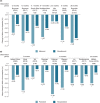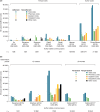Adherence to and persistence with antidiabetic medications and associations with clinical and economic outcomes in people with type 2 diabetes mellitus: A systematic literature review
- PMID: 34779107
- PMCID: PMC9299643
- DOI: 10.1111/dom.14603
Adherence to and persistence with antidiabetic medications and associations with clinical and economic outcomes in people with type 2 diabetes mellitus: A systematic literature review
Abstract
We designed a systematic literature review to identify available evidence on adherence to and persistence with antidiabetic medication in people with type 2 diabetes (T2D). Electronic screening and congress searches identified real-world noninterventional studies (published between 2010 and October 2020) reporting estimates of adherence to and persistence with antidiabetic medication in adults with T2D, and associations with glycaemic control, microvascular and/or macrovascular complications, hospitalizations and healthcare costs. Ninety-two relevant studies were identified, the majority of which were retrospective and reported US data. The proportions of patients considered adherent (median [range] 51.2% [9.4%-84.3%]) or persistent (median [range] 47.7% [16.9%-94.0%]) varied widely across studies. Multiple studies reported an association between greater adherence/persistence and greater reductions in glycated haemoglobin levels. Better adherence/persistence was associated with fewer microvascular and/or macrovascular outcomes, although there was little consistency across studies in terms of which outcomes were improved. More adherent and more persistent patients were typically less likely to be hospitalized or to have emergency department visits/admissions and spent fewer days in hospital annually than less adherent/persistent patients. Greater adherence and persistence were generally associated with lower hospitalization costs, higher pharmacy costs and lower or budget-neutral total healthcare costs compared with lower adherence/persistence. In conclusion, better adherence and persistence in people with T2D is associated with lower rates of microvascular and/or macrovascular outcomes and inpatient hospitalization, and lower or budget-neutral total healthcare expenditure. Education and treatment strategies to address suboptimal adherence and persistence are needed to improve clinical and economic outcomes.
Keywords: GLP-1RAs; adherence; healthcare costs; insulin; oral antidiabetic medications; persistence; resource utilization; type 2 diabetes.
© 2021 The Authors. Diabetes, Obesity and Metabolism published by John Wiley & Sons Ltd.
Conflict of interest statement
M.E. has received honoraria from AstraZeneca, Boehringer Ingelheim and Novo Nordisk. S.E. and M.F. are employees of Novo Nordisk A/S. J.F. was an employee of Novo Nordisk A/S at the time of the review, and is now an employee of Ferring Pharmaceuticals A/S. P.H. is an employee of Mtech Access, funded by Novo Nordisk A/S to carry out the SLR. W.P. has served as a consultant for Eli Lilly, Novo Nordisk and Sanofi.
Figures


References
-
- Alzaid A, Ladron de Guevara P, Beillat M, Lehner Martin V, Atanasov P. Burden of disease and costs associated with type 2 diabetes in emerging and established markets: systematic review analyses. Expert Rev Pharmacoecon Outcomes Res. 2021;21(4):785‐798. - PubMed
-
- Diabetes.co.uk. Type 2 Diabetes. 15 January 2019. https://www.diabetes.co.uk/type2-diabetes.html. Accessed August 5, 2021.
-
- Zhuo X, Zhang P, Hoerger TJ. Lifetime direct medical costs of treating type 2 diabetes and diabetic complications. Am J Prev Med. 2013;45(3):253‐261. - PubMed
Publication types
MeSH terms
Substances
LinkOut - more resources
Full Text Sources
Medical

